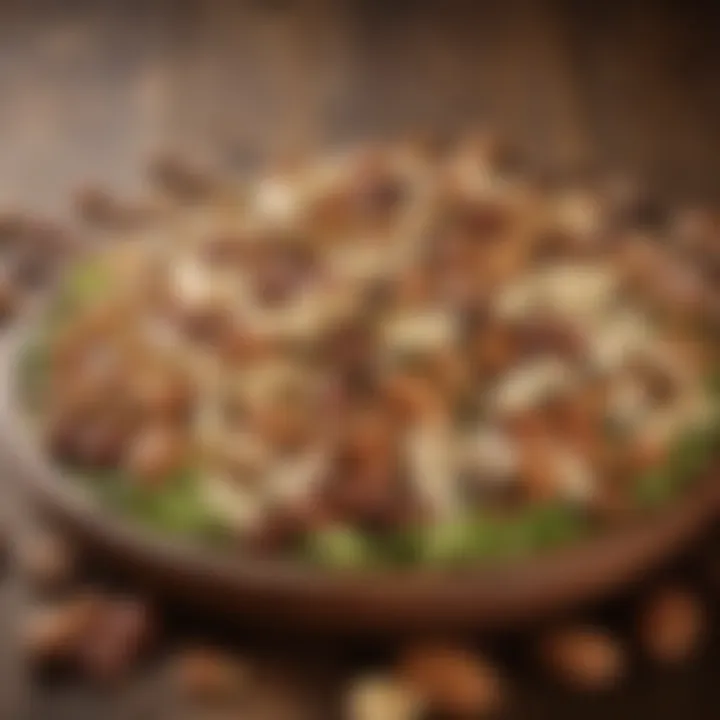Raw Vegan Diet: Nutritional Insights and Choices


Intro
The realm of dietary practices has seen a significant surge in interest, with the raw vegan diet emerging as a noteworthy contender. This lifestyle is more than just a fad; it's a conscientious approach to nutrition that prioritizes raw, unprocessed plant foods. Many individuals find themselves drawn to this way of eating for a variety of reasons, be it health consciousness, ethical considerations, or simply a desire for a more sustainable lifestyle. With the integration of fresh fruits, vegetables, nuts, seeds, and sprouted grains, a raw vegan diet can provide not only an array of flavors but also a multitude of health benefits.
Understanding the essence of a raw vegan diet requires one to appreciate the balance between taste and nutrition, ensuring that meal planning is both satisfying and nourishing. Through this exploration, we will dissect the essential components that make up a raw vegan lifestyle, spotlighting the key nutrients often overlooked and offering practical tips for everyday implementation. Whether one is looking to dip their toes in the waters of raw veganism or dive headfirst into the lifestyle, this guide will serve as a comprehensive resource for successful meal planning without sacrificing flavor or nutrition.
Understanding Raw Veganism
Understanding the foundational aspects of raw veganism is crucial for anyone looking to navigate this unique dietary lifestyle. This section serves as a gateway into the world of raw veganism, addressing not just what it entails, but why it has gained traction among health enthusiasts. This approach to eating embraces the freshness of food in its most natural state, often resulting in a rich tapestry of flavors and textures. Grasping the essence of raw veganism allows individuals to appreciate its health benefits, ethical considerations, and culinary possibilities more fully.
Defining Raw Veganism
Raw veganism is a dietary paradigm that combines two primary elements: a raw food diet and vegan principles. Essentially, this means consuming plant-based foods that are uncooked and unprocessed. To be considered 'raw', food typically must not be heated above 104 to 118 degrees Fahrenheit (40 to 48 degrees Celsius). This temperature threshold is significant, as it is believed to preserve enzymes and nutrients that cooking can diminish or destroy. The staples of a raw vegan diet include fruits, vegetables, nuts, seeds, and sprouted grains.
At its core, raw veganism isn't just about avoiding animal products or cooked foods; it's about a lifestyle that supports health through unrefined, organic ingredients. The philosophy advocates for easy digestion and superior nutrient absorption by minimizing the consumption of processed items. Plus, it reconnects individuals to their food sources, fostering an appreciation for the vibrant colors and natural flavors that fresh produce can offer.
The Philosophy Behind Raw Veganism
The philosophy of raw veganism extends beyond dietary choices; it encompasses ethical, environmental, and health considerations. For many adherents, the decision to embrace this diet is deeply rooted in environmental consciousness. Consuming raw, plant-based foods reduces dependence on animal agriculture, leading to less land degradation and decreased greenhouse gas emissions.
Moreover, many raw vegans believe that a diet rich in unprocessed foods maximizes one’s health potential. The focus is on obtaining nutrients from vibrant vegetables and fruits, which are teeming with vitamins, minerals, and antioxidants. This perspective emphasizes the healing properties of food and how they can significantly influence overall well-being.
"A raw vegan diet is about more than just what you eat; it’s about a commitment to a sustainable lifestyle that honors the planet, animals, and the human body alike."
Differentiating Raw Veganism from Other Diets
Understanding raw veganism also requires distinguishing it from other dietary patterns. While several diets emphasize plant-based foods, raw veganism has its unique features. For instance, many vegetarians or vegans consume cooked foods, while raw vegans strictly refrain from cooking anything. This creates a noticeable divergence in terms of available foods and preparation methods.
Another notable difference is with other types of raw diets, such as the raw omnivore diet, which allows animal products in raw forms. However, raw vegans strictly avoid all animal-based ingredients, valuing plant foods as their primary source of sustenance.
For those interested in exploring culinary versatility, raw veganism opens doors to innovative meal preparations. The use of techniques such as dehydrating, sprouting, and blending transforms simple ingredients into creative dishes that rival traditional cooking methods.
Additionally, it’s vital to note how raw veganism emphasizes seasonal and local produce, which stands in contrast to the often global nature of many diets today. This reinforces its commitment not only to health but to sustainable and responsible food sourcing, offering a refreshing perspective in a fast-paced world.
Core Food Categories in a Raw Vegan Diet
In the realm of raw veganism, the food categories play a pivotal role. They are not mere components of a meal, but foundational building blocks for a vibrant, nourishing lifestyle. Each category brings its unique flavors, textures, and health benefits to the table, creating a diverse and satisfying diet. Understanding these categories can significantly expand culinary horizons and enhance overall well-being.
Fruits: Nature's Sweetness
Varieties of Fresh Fruits
Fruits are the natural sweets of the world, bursting with vibrant colors and flavors. Varieties range from common apples and bananas to exotic dragon fruits and mangosteens. Each type has distinct nutritional profiles; for instance, berries, particularly blueberries, are packed with antioxidants. Choosing a wide array of fruits not only satisfies the sweet tooth but ensures a broad range of vitamins and minerals. Additionally, the hydration factor in many fruits, like watermelon and oranges, is a great plus for overall health. However, it's worth noting that some fruits, like bananas, contain higher sugar levels, which might not be ideal for everyone.
Seasonal Considerations
Navigating seasonal fruit choices can become a delightful adventure. Eating seasonally means choosing fruits that are naturally ripe, providing enhanced flavor and nutrients. For instance, summer's abundance of peaches and cherries contrasts beautifully with winter's citrus fruits. This practice reduces the carbon footprint, too, allowing for a more sustainable approach to eating. However, when opting for seasonal choices, access may be limited to local availability, necessitating some flexibility in meal planning.
Tips for Flavorful Pairings
Pairing fruits can elevate a dish from ordinary to extraordinary. Combining sweet and tart elements, such as pairing mango with lime, can create delightful contrasts in flavor. You can also experiment with textures—think crunchy apples with creamy nut butter. Fresh herbs, like mint or basil, can add an unexpected twist and enhance flavors significantly. While experimentation is key here, individuals may sometimes find certain combinations unpalatable, leading to a trial-and-error process.
Vegetables: A Nutrient Powerhouse
Leafy Greens and Their Benefits
Leafy greens are packed with essential nutrients and low in calories, making them a staple in a raw vegan diet. Spinach, kale, and Swiss chard are just a few examples that offer a treasure trove of vitamins, minerals, and fiber. Eating these greens raw retains their nutrients, unlike cooked counterparts. They also provide chlorophyll, which is touted for its potential detoxifying properties. However, people should be aware that oxalates present in some greens, like spinach, can interfere with calcium absorption if consumed excessively.
Crunchy Vegetables for Texture
Crunchy vegetables like bell peppers, cucumbers, and carrots not only add a satisfying crunch but also bring essential nutrients into the mix. They are low-calorie, hydrating, and rich in dietary fiber, which aids in digestion. Incorporating these veggies into meals creates a balanced texture, contrasting with softer items like avocado. On the flip side, some crunchy options can be quite high in natural sugars, especially when it comes to certain root vegetables like carrots.
Fermented Vegetable Options
Fermented vegetables, including sauerkraut and kimchi, play a unique role in a raw vegan diet by introducing beneficial probiotics. These probiotics can support gut health, enhancing digestion and potentially boosting immunity. The fermentation process often amplifies flavors, adding a tangy depth to dishes. Though popular among many, some might be off-put by the strong taste of fermented items or unsure about how to incorporate them into their meals.
Nuts and Seeds: Sources of Protein and Fat
Popular Nuts in Raw Diets
Nuts like almonds, walnuts, and pecans are essential sources of healthy fats, protein, and fiber. They provide a satisfying crunch to salads or smoothies and are often used to create rich nut milks or cheeses. The high omega-3 content in walnuts can be especially beneficial for heart health. However, portions should be moderated as calorie-dense foods, leading to potential weight gain if overconsumed.
Health Benefits of Various Seeds
Seeds like chia, flax, and pumpkin are often overlooked but are nutritional powerhouses. Chia seeds are rich in omega-3 fatty acids, while flaxseeds can provide a good source of lignans, which have antioxidant properties. Including seeds in meals can boost the overall nutrient profile and provide various health benefits. It’s paramount, though, to include seeds in a ground form for better nutrient absorption; whole seeds may pass through the digestive system undigested.
Creating Nut-Based Spreads and Dips


Nut-based spreads and dips are incredible ways to introduce healthy fats into meals. Hummus made with soaked cashews or almond butter can serve as a luscious accompaniment to veggies or fruits. These spreads are versatile and can be flavored in numerous ways, such as adding spices or sweeteners. However, one must be cautious of excessive salt and additives in store-bought versions, opting for homemade whenever possible.
Sprouts: Tiny Nutritional Giants
How to Grow Your Own Sprouts
Growing your own sprouts is surprisingly simple and provides a fresh, nutrient-rich addition to your meals. By soaking seeds like alfalfa or mung beans and keeping them in a jar, you can enjoy fresh sprouts within days. This do-it-yourself approach ensures that you know exactly what goes into your food and supports a more sustainable lifestyle. While it’s a rewarding endeavor, individuals need to be aware of cleanliness to avoid contamination during the sprouting process.
Nutritional Benefits of Sprouts
Sprouts are delightful little powerhouses, often richer in vitamins and minerals than their mature counterparts. For instance, sprouted lentils can provide higher protein levels and easier digestibility because of the sprouting process. These little guys can easily be added to salads or sandwiches, giving a boost of nutrition without the fuss. Nonetheless, because they are raw, some people might experience digestive discomfort depending on their sensitivity.
Integrating Sprouts into Meals
Integrating sprouts into meals is not just easy; it’s creative. They can be sprinkled on salads, blended into smoothies, or used as topping for raw wraps. Their delicate crunch adds a fresh note to various dishes. However, their short shelf life means they must be consumed quickly, which might require careful planning when adding them to the weekly meal prep.
Raw Grains: An Overlooked Category
Types of Edible Raw Grains
While grains are often left out of raw vegan diets, certain types can be included, like buckwheat and quinoa when sprouted or soaked. These are packed with nutrients and provide a chewy texture that can complement salads or be made into porridge. Including these grains opens up more diverse options in the kitchen. But, caution must be taken since some grains can be hard to digest if not prepared properly.
Benefits of Soaking and Sprouting
Soaking grains not only enhances digestibility but also activates enzymes, unlocking their nutritional potential. Sprouting grains like quinoa or buckwheat often transforms their flavor profile, creating a more appealing taste. However, soaking requires planning and patience, as grains typically need a few hours or overnight soaking to prepare.
Incorporating Grains into Recipes
Finding ways to incorporate raw grains into meals can enhance variety and provide different textural experiences in dishes. Utilizing sprouted grains in salads or blending soaked oats in smoothies can yield filling and nutritious options. While tempting to experiment, one must tread carefully to avoid overpowering the dish's flavors with grains that might be too earthy or heavy.
Key Nutrients in a Raw Vegan Diet
Adopting a raw vegan diet necessitates a focused approach to nutrient intake. It’s essential to ensure that the absence of cooked foods does not lead to nutritional deficiencies. This segment highlights the key nutrients one should be aware of, emphasizing the vital role they play not only in sustaining energy but also in promoting overall health and well-being.
Essential Vitamins and Minerals
Vital vitamins and minerals can largely be found in raw foods, enriching the diet and helping prevent deficiencies. Let’s look at some crucial nutrients.
Vitamin Sources
Vitamin C is a powerhouse for immune function and skin health. Fresh fruits, particularly oranges, kiwis, and strawberries, are at the forefront of this nutrient group. They not only offer a tart sweetness but also bring lots of juice to the table, making them a popular choice in raw diets. The unique aspect of these fruits is their ability to restore energy levels, especially during hot weather, offering hydration alongside nutrition.
Advantages: Vitamin C from these sources helps prevent common colds and acts as a robust antioxidant. However, it’s also important to consume them fresh, as cooking can significantly reduce their vitamin concentration.
Calcium-Rich Choices
Calcium is often associated with dairy, but there are several plant-based alternatives that work wonders. Leafy greens and nuts, especially sesame seeds, stand out as excellent sources. They provide the necessary mineral for strong bones and teeth without the need for animal products.
Unique Feature: Having multiple options means one can easily cater to individual tastes. The downside? Some may find it harder to absorb calcium from plant sources due to the presence of oxalates, which can inhibit absorption.
Ensuring Iron Intake
Iron is paramount in transporting oxygen within the body, making it critical for energy levels. In the realm of raw veganism, legumes, leafy greens, and nuts are common iron sources. These foods also pack in a punch of flavor and texture, contributing to the overall meal experience.
Key Characteristic: Pairing these iron-rich foods with vitamin C sources can enhance absorption dramatically, creating a more nutritious meal. However, raw iron, particularly from plant sources, is non-heme iron, which is not absorbed as efficiently, which is worth considering for those reliant solely on plants for their iron needs.
Importance of Protein Intake
Protein is the building block for muscles and plays a crucial role in overall health. In a raw vegan diet, ensuring sufficient protein can involve some creativity and planning.
High-Protein Plant Foods
Incorporating high-protein foods like hemp seeds, flaxseeds, and almonds can significantly aid in meeting daily protein requirements. These foods are not only rich in protein but also provide healthy fats, balancing out one’s diet nicely.
Why It Matters: They make great additions to smoothies or salads, enhancing both flavor and nutrition. One consideration here is to be mindful of portion sizes, as the caloric content can add up quickly.
Balancing Amino Acids
A complete protein profile includes all essential amino acids. While many plant sources lack one or more amino acids, combining different foods can create a full spectrum. For example, pairing legumes with grains can provide a well-rounded protein intake.
Key Feature: This approach means you don’t have to get complete proteins in one meal; the body can utilize amino acids from various meals throughout the day. On the flip side, some might find this approach cumbersome or confusing at first, but practice makes it easier.
Protein-Rich Meal Ideas
Crafting meals that spotlight protein is another way to ensure adequate intake. Raw vegan meals can include dishes like nut burgers or quinoa salads, which can be nourishing and filling. They can also tempt the taste buds with exciting flavors.
Noteworthy: The reality of planning such meals is that it can require ingenuity, especially when one is new to the diet. Having a repertoire of go-to recipes can simplify this process.


Healthy Fats: A Strategic Approach
Healthy fats are critical in any diet, aiding in nutrient absorption and offering energy. For a raw vegan diet, knowing where to find these fats can lead to a well-balanced approach.
Sources of Omega-3 Fatty Acids
Flaxseeds and walnuts stand out as rich sources of omega-3 fatty acids. These fats provide essential health benefits, particularly for heart health. They also contribute to cognitive function, making them a must-have in daily meals.
Characteristic: Having these fats in your diet helps lower inflammation and combats oxidative stress. It’s crucial to ground whole seeds, as the body may struggle to digest them otherwise.
Cooking Tips for Raw Fats
While the notion of cooking fats may seem counterintuitive, considering how to incorporate raw fats effectively is vital. Adding avocados into smoothies or salads provides both creaminess and a health boost.
Unique Aspect: The rich texture of these fats can enhance other ingredients, making meals more satisfying. One must keep in mind, though, that these fats are calorie-dense, so moderation is key.
Utilizing Avocado and Coconut
Avocados and coconuts are popular in many raw vegan circles. The creamy consistency of avocados and the delicious sweetness of young coconuts bring a myriad of benefits to meals.
Benefit: They provide potassium, magnesium, and a range of healthy fats that are crucial for heart health. However, the cost of fresh coconuts can be a consideration, as they’re often more expensive compared to other fruits.
Generally speaking, understanding key nutrients is essential for anyone considering a raw vegan lifestyle. It enables them to build meals not just based on preferences, but also on solid nutritional foundations, laying the groundwork for a healthy and vibrant life.
Practical Meal Ideas for Raw Vegans
In the world of raw veganism, meal ideas play a crucial role in maintaining enthusiasm and commitment. When adopting a raw vegan diet, variety becomes your best friend. Whether it’s breakfast, lunch, dinner, or even snacks, having an array of practical meal ideas makes the journey both enjoyable and sustainable. This section will highlight simple yet satisfying recipes that prioritize nutrition, flavor, and accessibility. The importance lies in finding meals that not only fuel the body but also cater to individual tastes and preferences, making it easier to stick to this vibrant lifestyle.
Breakfast Options
Starting the day right with a nutritious breakfast sets a positive tone for the hours ahead. Raw breakfast options can be both energizing and delightful, packing in essential nutrients while keeping the palate excited.
Smoothie Bowl Recipes
Smoothie bowls are a vibrant way to kick off the day. They offer tons of flexibility, allowing one to mix and match ingredients according to what’s on hand. A smoothie bowl’s key characteristic lies in its thick texture, which means you can enjoy it with a spoon. This is unlike traditional smoothies that are often consumed from a glass. Focus on blending your favorite fruits—like bananas, berries, and mangoes—with a bit of leafy greens for added nutrients. Top it all off with seeds, nuts, or coconut flakes. This isn’t just a breakfast; it’s a canvas.
The unique feature of smoothie bowls is the option for customization. You can create a different flavor combination every day, making them a popular breakfast choice. The advantage is that you can consume a wide range of nutrients and satisfy your sweet tooth simultaneously. However, one should be cautious about adding too many sweet ingredients, which can skew overall sugar intake.
Overnight Chia Pudding
Overnight chia pudding is another stellar breakfast choice. The main element that makes it special is the chia seed's ability to absorb liquid and form a gel-like consistency overnight. This dessert-like breakfast provides a rich source of fiber, omega-3s, and protein, appealing to many health-conscious individuals.
Highlighting its simplicity, you just mix chia seeds with almond milk, let it sit in the fridge, and voilà! In the morning, you’ll have a creamy pudding ready to go. It’s easy to adjust flavors, whether by adding vanilla, cacao, or fresh fruits. The main advantage is how easy it is to prepare in bulk for busy weekdays. The downside might be the texture, which could be off-putting for those unfamiliar with chia.
Fresh Fruit Platters
Fresh fruit platters are like a panorama of nature’s candy. They not only appeal visually but also invite you to experience a diverse range of textures and flavors in one serving. This option is incredibly simple, as it requires no cooking—just chopping and arranging.
The key characteristic is its simplicity and freshness. You can include seasonal fruits or whatever is on hand, like apples, pears, strawberries, and kiwi. Many find this a beneficial choice because it delivers vitamins and antioxidants in a way that feels indulgent yet healthy. One unique aspect is the versatility. You can mix fruits for a vibrant brunch or present them to guests as an impressively healthy display. Another consideration would be that it may not keep as long, so it's best prepared fresh.
Lunch Ideas
Lunchtime is another opportunity to fill your plate with colorful raw food that can keep you zipping through the afternoon.
Raw Wraps with Nutri-Filling
Raw wraps combine a variety of flavors and textures wrapped up in leafy greens. Typically made with large lettuce or collard green leaves, these wraps can be layered with various nutri-fillings such as hummus, avocado, grated veggies, and sprouts. The variety is certainly appealing.
One of the key characteristics of this meal is its portability, perfect for those on the go. They provide the satisfaction of a full meal without heating. With the ability to stuff them with whatever ingredients you have, they are versatile—catering to picky eaters with different tastes. However, one might find that the crunchiness of the leaves can make them less filling compared to a traditional wrap.
Salads Packed with Superfoods
Salads in raw veganism tend to go beyond just lettuce and dressing. When packed with superfoods like quinoa, hemp seeds, kale, and various seeds, they really come to life. This is something many raw vegans love to prepare, as each salad can burst with flavor and nutrients.
The key characteristic here is that superfoods bring added health benefits, fuelling your day with high energy. The unique feature is how simple yet richly nutritious a salad can be. It’s a great way to get a range of vitamins and minerals all in one meal. However, the disadvantage might be the time spent chopping and preparing multiple ingredients.
Sushi Rolls with Veggies
Sushi rolls made with raw ingredients come off as both flavorful and a fun way to serve lunch. Using sheets of nori, one can wrap spiraled zucchini, cucumber, carrots, and even avocado into bite-sized pieces. The freshness shines through.
The key draw of veggie sushi is its visual appeal and creative flexibility. People enjoy these rolls not just for their taste, but also because they can get quite artistic in the kitchen. The unique feature lies in how they can make raw vegetables exciting. However, they might not offer enough carbohydrates for some, leading to a craving for something more filling later.
Dinner Suggestions
Dinner can serve as a perfect time to showcase hearty raw meals that satisfy you yet are still light on digestion.
Cabbage Leaf Rolls


Cabbage leaf rolls can be filled with savory mixtures of veggies, nuts, and herbs, offering substantial nutrition packed into easy-to-eat bundles. The beauty of this dish is its flexibility; you can stuff them with virtually anything—from lentil salads to mashed avocado.
The primary characteristic is that they are hands-on and fun to prepare, which can engage family members in a shared cooking moment. Plus, they are satisfying and can easily be adjusted to suit your tastes. One distinct advantage is that cabbage is often more stable in the fridge, remaining fresh longer than many ingredients. One minor drawback is that cabbage may not appeal to all.
Zucchini Noodles with Raw Sauce
Zucchini noodles offer a refreshing twist on traditional pasta dishes. They have gained popularity due to their low carb count while still satisfying the cravings for something hearty. Turn your zucchini into wraps using a spiralizer, then top them with a raw sauce made from tomatoes, herbs, and spices.
The key characteristic is their adaptability. You might experiment with different sauces or toppings every time you make them. This is a great way to combine various flavors in one bowl. A downside? They can lose texture quickly, especially if made too far in advance.
Stuffed Peppers with Quinoa
Stuffed peppers can be more than just a warm dish; they can show how raw vegan cooking can align with traditional comfort food. Fill halved peppers with a mixture of sprouted quinoa, sunflower seeds, and spices. This takes a straightforward dish and makes it something elegant.
The main advantage of stuffed peppers is their nutrient density and visual appeal. They offer contrasting flavors and textures, making them not just a meal, but an experience. The unique feature is their presentation, as they can look stunning on any table, yet they do require some preparation time.
Snacks and Desserts
Snacks and desserts are often seen as indulgences, but they can fit right into a raw vegan lifestyle.
Energy Balls with Nuts
Energy balls made from a mix of nuts, seeds, and fruits are perfect for an afternoon pick-me-up. They can be rolled with coconut or cocoa powder for added flavor. The primary characteristic is their convenience; they are easy to make and grab for on-the-go energy.
These bites provide quick fuel without any cooking. The unique aspect is how satisfying they can be while ensuring you are getting healthy fats and protein. However, one must be cautious with portion sizes, as they can be calorie-dense.
Raw Vegan Cheesecake
Say goodbye to baked cheesecakes; raw vegan cheesecakes offer a creamy indulgence without the oven. Made from cashews, coconut oil, and raw sweeteners, they are decadent and can be made into various flavors by adding fruits or toppings.
The primary characteristic is their rich texture, often surprising to those unfamiliar with raw dessert recipes. Offering options for those seeking to keep sugar intake low, they provide that feeling of decadence without the guilt. A disadvantage could be the longer preparation time, particularly if you need to soak cashews overnight.
Fruit and Nut Bars
Fruit and nut bars are delightful to munch on whenever the cravings hit. They are typically made with blended fruits and various nuts pressed into a bar shape. The simplicity of the recipe makes them a favorite among many.
The key characteristic here is their portability. They make for a perfect snack while being nutrition-dense. The unique feature is how easily they can be modified according to your favorite tastes and ingredients. However, they can be sweet, depending on the fruits used, which might not suit everyone.
Tools and Techniques for Preparing Raw Vegan Meals
When it comes to embracing a raw vegan lifestyle, having the right tools and techniques is crucial. These utensils and methods can make meal prep not only simpler but also enhance the overall enjoyment of the food. With raw vegan meals, the art lies in preserving the integrity and nutrients of the ingredients. Using the appropriate equipment allows for creative meals while maintaining high nutritional value.
Essential Kitchen Tools
Blenders and Food Processors
Blenders and food processors are the backbone of preparing a raw vegan diet. They help in making creamy smoothies or chunky spreads, turning natural ingredients into various textures. One key characteristic of these appliances is their versatility. They can be used to whip up a smoothie, create nut butters, or even mix dressings, making them a popular choice for raw food preparation.
An important feature of modern blenders is their power. High-speed options can blend tough ingredients like leafy greens and seeds, achieving a silky texture that is pleasant to the palate. However, it’s worth mentioning that not all blenders are created equal. While high-powered blenders can be expensive, they save time and hassle in the long run. Choosing an underpowered model may lead to frustration, as blending can become a chore rather than a delight.
Spiralizers for Vegetables
Spiralizers are a game-changer for raw vegans looking to recreate pasta without the grains. This nifty tool turns vegetables like zucchini or carrots into noodle-like forms, appealing to both eye and tastebud. The unique feature of spiralizers is their ability to transform mundane veggies into exciting dishes. A plate of spiralized veggies not only looks appetizing but also provides a healthy alternative to traditional pasta.
The benefits are clear: using a spiralizer makes it easy to increase vegetable intake while keeping meals fun and creative. However, a potential downside is that they can be cumbersome to clean if not designed well. Finding a spiralizer that balances easy use and maintaining sharp blades can enhance your experience significantly.
Dehydrators for Snacks
Dehydrators offer a unique approach to raw vegan meals. This appliance removes moisture from foods, resulting in flavorful, chewy snacks that maintain their raw status. One primary advantage of dehydrators is that they allow for the diversifying of textures in a raw diet, turning fruits into chewy snacks or veggies into crispy chips. This can be a wonderful way to enjoy healthy alternatives to typical snack foods.
The concept of dehydration facilitates preservation, ensuring that ingredients are available over time while retaining their nutritional value. However, it does require an upfront investment of time. Some users may find the process slow, waiting hours for their snacks to be ready. But the payoff of having a stash of healthy snacks can make this inconveniance well worth it.
Preparation Techniques
Chopping and Slicing Methods
Proper chopping and slicing methods can enhance the presentation and texture of raw meals. A sharp knife is essential for safe and effective cutting, ensuring that fruits and vegetables stay fresh and appealing. One unique aspect of this technique is the art of creating uniform pieces to ensure even marinating or flavor absorption.
Mastering these methods not only elevates the quality of your dishes but also aids in maintaining a smoother cooking process. It can prevent tears when slicing onions or preserve the crunchy nature of certain vegetables. The downside is that it may require practice to achieve precision. However, over time, the improvements in speed and presentation could be very rewarding.
Marinating Tips for Depth of Flavor
Marinating is key for raw vegans to infuse meals with layers of flavor. Usually, marinating not only enhances taste but also softens textures, making bites more palatable. The importance of layering flavors here cannot be overstated; using various herbs, spices, or acids can transform an otherwise bland dish into something phenomenal.
The special aspect of marinating in a raw diet is that it can be done with whole food ingredients. Instead of relying on processed options, one can use fresh herbs and fruits to create a concoction that opens up the full potential of a dish. However, one drawback is patience; allowing sufficient time for marinating can take hours or even overnight. But the difference in flavor can justify the wait.
Dehydration vs. Fermentation
Understanding the difference between dehydration and fermentation can be beneficial for those following a raw vegan diet. Dehydration allows for the preservation and concentration of flavors, while fermentation introduces beneficial bacteria that contribute to gut health. Both techniques offer unique benefits to a raw diet, providing different flavors and textures.
A standout characteristic of fermentation is its ability to increase nutritional value, making foods more digestible and adding probiotics. On the other hand, dehydration lets individuals enjoy their favorite flavors in a long-lasting format. The considerations here involve time and personal preference, as both methods require attention but yield rewarding and delicious results. In the end, combining both techniques can broaden one's culinary horizons.
"The fusion of proper tools and techniques transforms the preparation of raw vegan meals from a task into a delightful adventure, where every step counts and flavors thrive."
In summary, equipping your kitchen with the right tools and mastering various preparation techniques are paramount in the journey of a raw vegan lifestyle. Both efforts amplify the joy and nutrition in every meal, inviting creativity while remaining firmly rooted in health.







